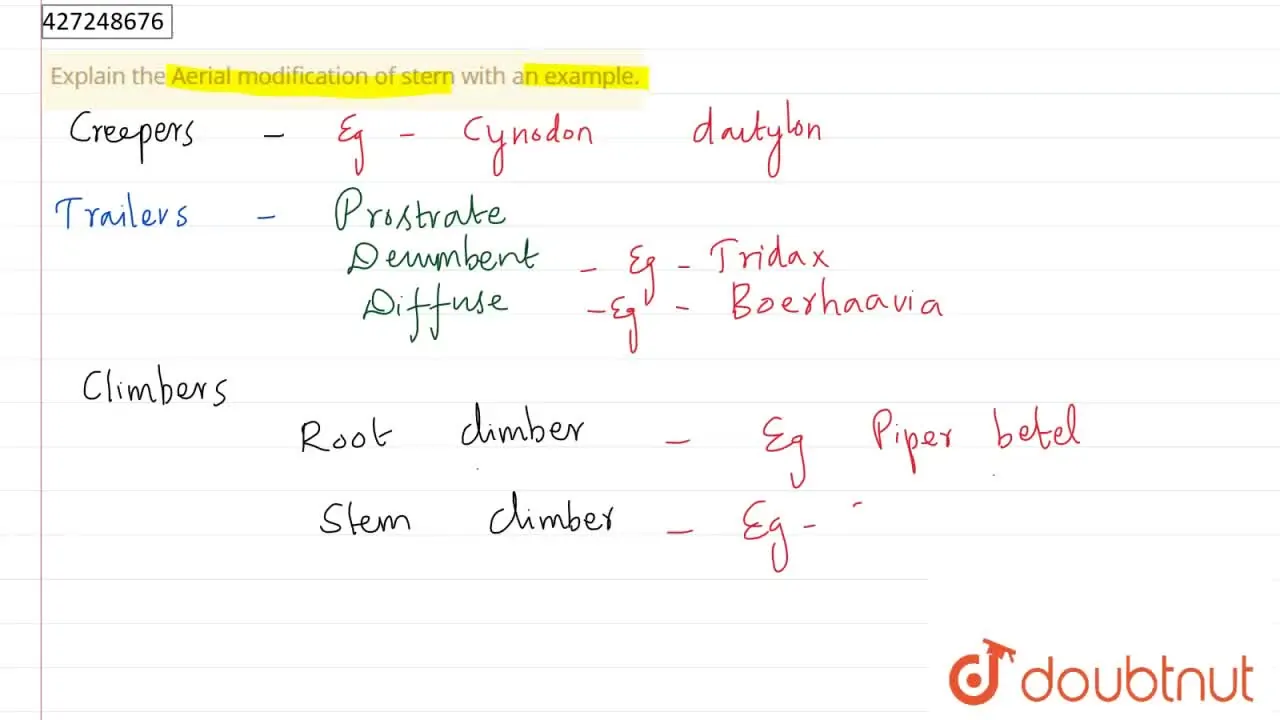Explain the Aerial modification of stern with an example.Solution in Tamil
Aerial modification of stem :
1. Creepers: These are plants growing closer (horizontally) to the ground and produces roots at each node. e.g., Cynodon dactylon, Oxalis, Centella
2. Trailers (Stragglers): It is a weak stem that spreads over the surface of the ground without rooting at nodes. They are divided into 3 types,
i. Prostrate (Procumbent) : A stem that grows flat on the ground. e.g., Evolvulus alsinoides, Indigofera prostrata.
ii. Decumbent : A stem that grows flat but becomes erect during reproductive stage. e.g., Portulaca, Tridax, Lindenbergia
iii. Diffuse : A trailing stem with spreading branches. e.g., Boerhaavia diffusa, Merremia tridentate
3. Climbers: These plants have long weak stem and produce special organs for attachment for climbing over a support. Climbing helps to display the leaves towards sunlight and to position the flower for effective pollination.
i. Root climbers: Plants climbing with the help of adventitious roots (arise from nodes) as in species of Piper betel, Piper nigrum, Hedera helix, Pothos, Hoya.
ii. Stem climbers (twiners) : These climbers lack specialised structure for climbing and the stem itself coils around the support. e.g., Ipomoea, Convolvulus, Dolichos, Clitoria, Quisqualis.
Stem climbers may coil around the support clockwise or anti-clockwise. Clockwise coiling climbers are called dextrose. Example: Dioscorea alata. Anti-clockwise coiling climbers are called sinistrose. e.g., Dioscorea bulbifera.
iii. Hook climbers: These plants produce specialized hook like structures which are the modification of various organs of the plant. In Artabotrys inflorescence axis is modified into hook. In calamus (curved hook) leaf tip is modified into hook. In Bignonia unguiscati the leaflets are modified into curved hook. In Hugonia the axillary buds modis into hook.
Iv. Thorn climbers : Climbing or reclining on the support with the help of thorns as in Bougainvillea and Carissa.
v. Lianas (woody stem climber): Woody perennial climbers found in tropical forests lianas. They twine themselves around tall trees to get light. e.g., Hiptage benghalensis, Bauhinia vahlii, Entada pursaetha.
vi. Tendril climbers: Tendrils are thread-like coiling structures which help the plants in climbing. Tendrils may be modifications of Stem - as in Passiflora, Vitis and Cissus quodrangularis, Inflorescence axis - Antigonon, Leaf - Lathyrus, Leaflets - Pisum sativum, Petiole - Clematis, Leaftip - Gloriosa, Stipules - Smilax. In pitcher plant (Nepenthes) the midrib of the leaf often coils around a support like a tendril and holds the pitcher in a vertical position.
Related Playlists
- BOOK - FULL MARKSCHAPTER - EXAMINATION QUESTION PAPER - JUNE 2019EXERCISE - Bio - Zoology (PART - I)8videos
EXAMINATION QUESTION PAPER - JUNE 2019
- BOOK - FULL MARKSCHAPTER - EXAMINATION QUESTION PAPER - JUNE 2019EXERCISE - Bio - Zoology (PART - II)6videos
EXAMINATION QUESTION PAPER - JUNE 2019
- BOOK - FULL MARKSCHAPTER - EXAMINATION QUESTION PAPER - JUNE 2019EXERCISE - Bio - Botany(PART - III)5videos
EXAMINATION QUESTION PAPER - JUNE 2019
- BOOK - FULL MARKSCHAPTER - DIGESTION AND ABSORPTIONEXERCISE - ADDITIONAL QUESTIONS SOLVED ( III. Answer the following Questions )46videos
DIGESTION AND ABSORPTION
- BOOK - FULL MARKSCHAPTER - EXAMINATION QUESTION PAPER - MARCH 2019EXERCISE - Bio - Zoology (PART - IV)4videos
EXAMINATION QUESTION PAPER - MARCH 2019
Similar Questions
Every unit of classification regardless of its rank is ………………….
02:51View SolutionCompare closed and opened circulatory system.
04:37View SolutionDo you agree that virus is living organism ? If you say yes, justify your answer.
03:13View SolutionWhat are the uses of food?
02:38View SolutionWrite the kingdom, phylum and class for Pigeon. Write the characteristics of birds that are suitable for flying.
02:36View SolutionThis is not an example of aerial modification of stem
04:15View SolutionWhat are sub aerial stem modifications? Explain the types of sub aerial stem modifications?
02:37View SolutionList out two sub-aerial stem modifications with example.
02:09View SolutionList out two sub-aerial modification with example.
05:39View SolutionAerial stem modification found in Bougainvillea
55:14View SolutionName the sub aerial modification of stem.
01:01:13View SolutionState the different types of sub-aerial modifications of stem.
04:38View SolutionState the different types of aerial modifications of stem.
02:21View SolutionGive an account of the sub - aerial stem modification
02:05View Solutionclassification OF buds: functions OF stems aerial stem modifications
01:16View Solution


